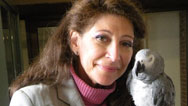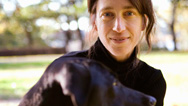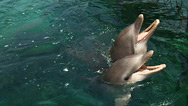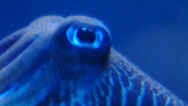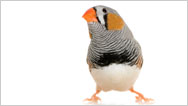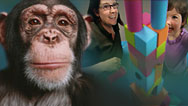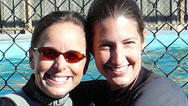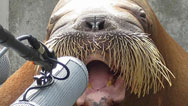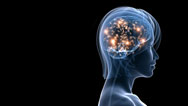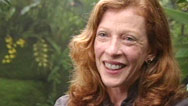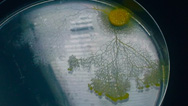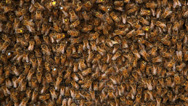
How Smart Are Animals?
Dogs, dolphins, parrots, and even octopuses (mere mollusks!) may be smarter than you think. Airing February 9, 2011 at 9 pm on PBS Aired February 9, 2011 on PBS
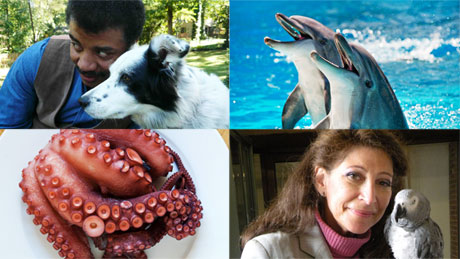
Program Description
Transcript
How Smart Are Animals?
PBS Airdate: February 9, 2011
NEIL DEGRASSE TYSON (Astrophysicist, American Museum of Natural History): Hi, I'm Neil deGrasse Tyson, your host of NOVA ScienceNOW, where this season we're asking six big questions. On this episode: How Smart Are Animals?
Meet Chaser. She's got a huge vocabulary.
She knows the name of every single one of these?
And it's not just her. Dogs are suddenly acing some tests that our closest relatives can't pass.
Look at that intensity.
And researchers are finally taking notice.
BRIAN HARE (Duke University): A dog is like a soldier of science.
NEIL DEGRASSE TYSON: Find Crawdad.
BRIAN HARE: If we can figure out how they think, then we'll understand ourselves.
NEIL DEGRASSE TYSON: Excellent, excellent, good job!
And a trip to paradise, where some of the smartest creatures...
TERI BOLTON (Roatan Institute for Marine Sciences): Come on, boy.
NEIL DEGRASSE TYSON: ...who can even read symbols, are also the most talkative.
TERI BOLTON: These are his clicks.
NEIL DEGRASSE TYSON: But what are they saying?
STAN KUCZAJ (University of Southern Mississippi): Is a whistle a word? Is it a sentence?
TERI BOLTON: Yes, French is very vocal.
NEIL DEGRASSE TYSON: Can we crack the dolphin code?
Also,...
ALEX (African Grey Parrot): Water.
NEIL DEGRASSE TYSON: ...communicating with animals is a lot easier, if...
IRENE PEPPERBERG (Brandeis University): What's it called?
NEIL DEGRASSE TYSON: ...they speak English.
ALEX: Shower.
IRENE PEPPERBERG: Right.
He was at the level of about a five- or six-year-old child.
NEIL DEGRASSE TYSON: This researcher spent her career with one remarkable bird,...
IRENE PEPPERBERG: How many?
NEIL DEGRASSE TYSON: ...Alex.
ALEX: Two.
IRENE PEPPERBERG: Good parrot.
For 30 years, Alex was the center of my life.
What do you want?
ALEX: Nut.
IRENE PEPPERBERG: You want a nut, you can have a nice big nut.
ARLENE LEVIN (Brandeis University): This is a parrot. How amazing is that?
IRENE PEPPERBERG: We were communicating with another species.
Can you tell me what's different?
ALEX: Color.
NEIL DEGRASSE TYSON: Are these just parlor tricks?
Find Darwin.
Or are these animals really intelligent?
Chaser's never even heard the name "Darwin."
All that and more on this episode of NOVA scienceNOW.
It's part of our pop culture to give animals human personalities and talents.
Good boy!
Movies and cartoons are filled with talking creatures who basically act like people, but they've got feathers or fur, from Donald Duck to Alvin and the Chipmunks.
And when it comes to our own pets, it's awfully tempting to imagine that they have human thoughts and feelings. But researchers have always been skeptical about animal intelligence. After all, we humans speak, write and build spaceships and solve puzzles, yet animals, well, they're just not that accomplished. Yet, recently, as we test more animals and try to reveal the way they think, we've come up with some surprising results.
And these days, one of our star pupils is the one animal who may know us the best.
ERIN JAMES (Dog Owner): She's a wonderful little dog. She is something special.
JONI FARMER (Dog Owner): He's really smart, and we have this connection.
SARAH JUMPER (Dog Owner): She is extremely intelligent.
GERVAIS HOLLOWELL (Dog Owner): I think that she is very much like a person.
JONI FARMER: I think Tucker understands me more than anyone else.
NEIL DEGRASSE TYSON: Plenty of dog owners have always said their dogs were smart, but animal researchers are just starting to catch on.
RESEARCHER: One, two, three, four.
NEIL DEGRASSE TYSON: New discoveries are showing that our "best friend" is smarter than they ever thought,...
RESEARCHER: Good job.
NEIL DEGRASSE TYSON: ...and that behind those big brown eyes, lies a brain that resembles ours in ways that we never imagined.
John Pilley, a chipper 82-year-old, started working with dogs as a psychology professor.
JOHN W. PILLEY (Wofford College): Walk up. Walk up. Walk up.
NEIL DEGRASSE TYSON: Now he's got one of the smartest dogs around.
JOHN PILLEY: Come on. Come on.
NEIL DEGRASSE TYSON: And I've come to check out what she can do.
JOHN PILLEY: Good girl.
NEIL DEGRASSE TYSON: Chaser is a six-year-old female border collie, a breed famously skilled at herding sheep.
JOHN PILLEY: She was born to live in the Scottish mountains...
Chaser!
...and herd sheep,...
Go, go, go.
...be a shepherd.
NEIL DEGRASSE TYSON: John has taught Chaser to tend an extremely large "herd," but there are no real sheep in it. Chaser's herd is made up of toys, about a thousand of them.
And she knows the name of every single one of these?
JOHN PILLEY: I hope.
NEIL DEGRASSE TYSON: Sailor.
John has assigned a name to each one...
Never Forget.
...and taught those names to Chaser.
JOHN PILLEY: She has about 12 elephants.
NEIL DEGRASSE TYSON: Apparently, sometimes John ran out of stuffed animals.
JOHN PILLEY: Uh oh, these are a pair of my shorts.
NEIL DEGRASSE TYSON: Oh, my...
JOHN PILLEY: No, no, that's one of her toys.
NEIL DEGRASSE TYSON: John claims that Chaser remembers the name of every single object in the pile. Personally, I find that hard to believe. I don't have time to test Chaser's memory on a thousand names, but I will test her on a random sample. John and Chaser go into the house so they can't see.
So, I'm going to get a handful of toys out of this pile and see if Chaser can identify them indoors.
With John and Chaser out of the room, I lay some of the toys out behind the couch...Inky, there's Lover.
Now it's time to see if Chaser really remembers their names.
All ready for Chaser.
JOHN PILLEY: Come, Chaser! Come to Neil.
NEIL DEGRASSE TYSON: Okay, come on now.
Chaser, find Inky.
Well, she got one right.
Find Seal.
Whoa, and that one, too!
Now you might be wondering what's going on behind the couch, like, "Is John handing her the toys?"
Find Crawdad.
Let's check our hidden camera.
Find Sugar.
I asked Chaser to find nine toys, and she got every single one right. And remember, I picked the toys randomly from this huge pile. Neither John nor Chaser saw which ones I picked.
On multiple trials with John and others, Chaser consistently aces her test.
There's a thousand toys here. That doesn't, like, spook you?
JOHN PILLEY: It makes me happy.
These dogs have super memories.
On your mark, get set, go. Over.
NEIL DEGRASSE TYSON: Chaser and other border collies like her have shown they can remember hundreds of words and what they represent.
JOHN PILLEY: Table, table. Reverse. Over.
NEIL DEGRASSE TYSON: What's more, they can learn these new words very quickly.
JOHN PILLEY: Table, table. Good girl.
NEIL DEGRASSE TYSON: So, how does this ability compare with other species?
Well, besides us, chimps and bonobos are the animal kingdom's top linguists, capable of learning sign language, but very slowly. And there are other tests where dogs perform much, much better than apes.
Consider this very simple task: by the age of 12 to 18 months a human baby knows to look or go where a grownup points.
BRIAN HARE: This is something that little children do right when they start to acquire language.
NEIL DEGRASSE TYSON: Brian Hare is a primate researcher who tried this experiment with some of our closest relatives, chimps and bonobos, with surprisingly bad results.
BRIAN HARE: Primates really struggle. If you try to help them, and you try to cooperatively communicate to them about the location of food, they're completely flummoxed. They don't understand.
NEIL DEGRASSE TYSON: Chimps and bonobos can solve some very sophisticated problems, but they don't always pay close attention to humans.
Brian suspected that this was one test where dogs could do better than the apes. Sure enough, when dogs were brought into the lab, they got the point.
BRIAN HARE: So, dogs, on the other hand, are really good at this. If you say, "Hey, the treat's over there," the dogs...zoom. They're really good, and they go find the thing. And relative to primates, it ends up dogs have a very special ability.
NEIL DEGRASSE TYSON: For Brian, the experiment highlights a basic difference between the way that dogs and bonobos view humans.
BRIAN HARE: When I see my dog, my dog wants me to be around. He wants me to be his social partner. He actually needs me. Whereas a bonobo and chimpanzee, they don't need me. They're basically like, "Hey, you got any food? Can I get any food off of you? Is there something I can do to trick you to t...? No, okay. Well, I'm going to go stay with my fellow bonobos and chimpanzees." They're not interested in making me happy.
NEIL DEGRASSE TYSON: Compared with primates, dogs are ideal research subjects, because they love to cooperate with humans.
RESEARCHER: Good girl.
BRIAN HARE: A dog is like a soldier. They're like a soldier of science. They show up and they''re like, "Yes, sir. I'm here to play. Let's do this game. Let's find out how my mind works. You know, is that a biscuit? Okay, I'm, I'm...it...whatever you need."
NEIL DEGRASSE TYSON: So even though primates like chimps and bonobos have bigger brains than dogs and are genetically much closer to us, Brian suspects that, in some ways, dogs' social intelligence might be more like our own.
RESEARCHER: Yes, you're a good boy.
NEIL DEGRASSE TYSON: That's one of the reasons why he and other primate researchers have recently started up new dog cognition labs.
BRIAN HARE: If we can figure out how they think and why they were shaped the way that they were, then we'll understand ourselves.
NEIL DEGRASSE TYSON: Look at that intensity. Look at that focus.
JOHN PILLEY: They're truly amazing.
NEIL DEGRASSE TYSON: So how were dogs' minds shaped?
JOHN PILLEY: Good girl, good girl.
NEIL DEGRASSE TYSON: Dogs evolved from wolves. Brian believes that something crucial happened to the dog's brain during that evolution from wild animal to pet that allowed it to pay closer attention to another species: people.
BRIAN HARE: It's an exciting idea that somehow dogs, during domestication, are shaped during tens of thousands of years to be able to read our social cues in a way that allows them to survive with us.
NEIL DEGRASSE TYSON: I met my first wolves at Wolf Park, in Indiana, where I visited with animal psychologist Clive Wynne.
CLIVE WYNNE (University of Florida): Hey, they've come to see you now.
NEIL DEGRASSE TYSON: These are among the tamest wolves in the world, raised by people, almost since the day they were born.
Still, we're warned to be extremely careful around them and not make any sudden movements.
CLIVE WYNNE: Wolves still can have very violent fights with people they are friends with. And that's why it's not wise to try and make pets of wolves.
NEIL DEGRASSE TYSON: And I also get the sense that they know that, in their head, you can see them thinking it. It's like, "I could rip your throat out if I wanted, but I just choose not to at this moment."
CLIVE WYNNE: They still have a more violent kind of social life. And they have very powerful jaws, and they can really do you some serious harm if they decide that you and they are now in some dispute about something...dinner, for example.
BRIAN HARE: Wolves, relative to dogs, are much more emotionally reactive around humans.
So, there really seems to have been evolution. There's been selection, actually, for dogs to be really interested and tolerant towards people.
NEIL DEGRASSE TYSON: Dogs are much less volatile than wolves. Brian thinks their emotional tolerance is what allows them to pay closer attention to humans, and, as a result, makes them more flexible students.
RESEARCHER: Chaser, find Neil, find Neil.
NEIL DEGRASSE TYSON: Take Chaser, John Pilley's brainy border collie.
RESEARCHER: Good girl, good girl.
NEIL DEGRASSE TYSON: Let's see what she does when we challenge her with a new toy she's never seen or heard the name of.
I smuggled this into your house. It's a Charles Darwin doll.
Okay, so I put seven toys behind the couch, plus Darwin. Chaser's never seen Darwin, hasn't even ever heard the name "Darwin." So we're going to see if she picks out Darwin by inference. That's what we're going to check.
I'm going to call her down now.
Chaser! Come on back! Let's have some more fun.
First, I'm going ask Chaser to find a couple of toys she already knows.
Find Sugar.
Excellent, Chaser! Okay, put him to bed.
Find Crawdad.
Excellent, excellent, good job! Okay, put it in the tub, put it in the tub.
Okay, here it comes, a name she's never heard before.
Find Darwin.
So, while searching for the other toys, Chaser knew exactly which one to pick up right away. Now, she seems to have think about which one might be Darwin.
It's taking her longer.
She takes so long, I call her back.
Chaser? Find Darwin. Find Darwin.
Finally, she makes a choice.
Darwin! You got Darwin!
I can't believe it. Chaser's never seen that doll before.
Darwin! You got Darwin! Good girl.
Yet somehow, she made the connection that the name she'd never heard before...
You found Darwin.
...went with the one toy she didn't recognize.
Good girl.
Chaser's not the only dog to do this.
That's Darwin.
And what's more, dogs like Chaser have shown that they will remember the connection they made between new name and new toy.
This is yet another way they can learn.
BRIAN HARE: What's interesting about seeing how dogs are learning these new words is that people thought this was really unique to humans, that this was something that was...only humans do this. But it seems that, no, that's not the case, that dogs can make these inferences about what novel utterances mean, and they can remember them for quite a long period.
Now, this looks just like what little children are doing. And so, it's remarkable, because the flexibility we see in dogs seems to be very similar to what you see in young children at a very important age in their development.
NEIL DEGRASSE TYSON: Dog research is just getting started, but hopes are high that this animal, so long ignored by science, may give us new insights into how learning works and offer a unique window into the evolution of the mind.
Why is Chaser so smart?
Researchers studying dog genomes found a gene that may be responsible.
It's called...CTNND2.
In humans, this gene is important for normal cognitive development.
The Border Collie genome shows selective breeding for this gene!
Well done.
When we see animals doing remarkable things, how do we know if we're simply seeing tricks or signs of real intelligence? Are talented animals just obeying commands, or do they have some kind of deeper understanding? One of the biggest challenges for animal researchers is to come up with tests that can distinguish between the two.
Correspondent Doug Hamilton traveled to a Caribbean cove to find out if some of our favorite performers are merely good at taking direction or if they're smart enough to put on a show all their own.
DOUG HAMILTON (Correspondent): This is not your typical science lab. It's a beautiful scuba diving resort called Anthony's Key. I've come here to meet the 24 Caribbean bottlenose dolphins that are in residence. Think of this as a really pretty school for dolphins.
Teri Bolton is their head trainer. She shows me the ropes...
TERI BOLTON: Finger up first.
DOUG HAMILTON: Finger up first.
...and the way to a dolphin's heart.
TERI BOLTON: You reach into the bucket and very gently drop it into his mouth.
Down the hatch.
DOUG HAMILTON: They got a lot of teeth in there.
TERI BOLTON: They do.
DOUG HAMILTON: Teri's trained the dolphins to do some pretty impressive things, and they seem more than happy to show off for me.
TERI BOLTON: Are you ready? Yeah, we're ready. Are you sure? Come on, boys.
They are amazing animals. They're very curious, they're very bright. So what we try to do, as trainers, is teach them the love of learning. We start every training session off on a high, and we want to leave it on a high. We are all about positive reinforcement. They love to be correct. Doesn't everyone?
DOUG HAMILTON: You cheer them on like you are playing with a dog. Is that what you are doing? Is that what...you are just encouraging that behavior?
TERI BOLTON: Yay, that was better.
I think we cheer them on like they're our kids. And you can see how they respond to that. You can see the brightness in their eyes, you can hear it in their vocalizations. They respond to that joy.
DOUG HAMILTON: Teri says that one of the best ways to experience the dolphin's world is to just dive right in, right into their world.
TERI BOLTON: Dolphins are so well adapted to life in the sea. Their brains have evolved to a higher level where they can play and create and problem-solve.
DOUG HAMILTON: A big challenge in figuring out how smart dolphins are is that their world is just so different from ours. Their brain even has powers ours does not.
To prove this point, Teri asked me to bury a ring underwater, outside of the dolphin's enclosure. Without being able to see the ring, Teri or any other human would have a very hard time finding it.
Mission accomplished. They'll never find it.
So she sends in Piya, the oldest male dolphin. They give him the command to find the ring. The audio on our underwater camera picks up Piya making a clicking sound.
TERI BOLTON: He's really searching hard for it.
DOUG HAMILTON: But this is more than just a noise. Dolphins can detect their sound bouncing back to them to sense their surroundings. Piya uses echo-location, like sonar, to track down the ring.
Good job, Piya!
TERI BOLTON: Good job, Piya!
DOUG HAMILTON: He outsmarted me.
TERI BOLTON: Good.
DOUG HAMILTON: The dolphin brain is large. In fact, relative to body size, it is the second largest only to humans, and is one indicator of their potential brain power.
Teri puts those brains to the test with an activity we humans clearly associate with intelligence: reading. Can dolphins understand commands by reading a symbol?
Looks like they can!
Watching these dolphins, it seems perfectly clear to me that they're really smart, but what do the scientists think?
STAN KUCZAJ: Are dolphins really intelligent? Yes, I definitely believe that that's the case. In fact, I think we have just scratched the surface of what dolphins are really capable of.
DOUG HAMILTON: Stan Kuczaj runs the Marine Mammal Behavior and Cognition Laboratory at the University of Southern Mississippi and is working to analyze and prove just how smart dolphins are.
TERI BOLTON: Put your finger back up.
DOUG HAMILTON: Finger up.
TERI BOLTON: Just wave.
DOUG HAMILTON: So we've been watching these animals do amazing things, but how do you know if they are doing something that's really just a rote, learned behavior versus doing something that actually shows how smart they are?
STAN KUCZAJ: That's a really good question. Dolphins learn to do a flip on command, and they learn to associate a trainer's signal with that behavior.
TERI BOLTON: Yay. Good job.
STAN KUCZAJ: But a more flexible problem-solving is when they can actually be a little bit more creative. That shows intelligence much more so than rote learning does.
DOUG HAMILTON: To see if dolphins could handle more than just rote learning, Kuczaj devised an experiment, a few years ago, to test a dolphin's ability not to just follow directions but to think things through and plan ahead.
STAN KUCZAJ: Planning's a real hallmark of intelligence.
DOUG HAMILTON: The dolphins were trained to pick up a weight and to put that weight in a box. They learned that if they put enough weights in, a fish would come out the bottom. The dolphins quickly figured out that they could get the fish faster, with a lot less work, by gathering up multiple weights in one trip.
STAN KUCZAJ: If you can plan, you can decide what course of action to take without actually having to try it first. That enables you to avoid a lot of risky situations and to be much more adaptable.
DOUG HAMILTON: Dolphins are social animals. They travel in groups. So can they plan together?
STAN KUCZAJ: I've seen dolphins in the wild, and all of a sudden all the dolphins get together and do a deep dive together. Obviously somebody's coordinated that behavior.
DOUG HAMILTON: How do they do that? Are they actually communicating? It would help if we could just ask them.
TERI BOLTON: What are you saying?
DOUG HAMILTON: Now, they make different sounds?
TERI BOLTON: Yes, French is very vocal.
DOUG HAMILTON: Show me the difference between a click and a whistle.
TERI BOLTON: Here's his whistle.
And these are his clicks.
DOUG HAMILTON: Scientists think these clicks and whistles could be the building blocks of a language, but no one has yet figured out how to translate them.
TERI BOLTON: Yeah, you have a lot to talk about don't you, mister.
DOUG HAMILTON: Stan and Teri have devised an amazing two-step experiment. It's designed to test whether dolphins are just trained performers or can they plan and come up with tricks of their own?
TERI BOLTON: Ronnie and Bill forward, Richie and Piya from shallow to way back.
DOUG HAMILTON: First the dolphins are asked to learn a concept, to create a trick of their own, not just a rote behavior.
Now, Stan and Teri are upping the ante. They want to see if their two star dolphins, Ronnie and Bill, can create something together. This means the dolphins are going to have to think, plan and, hopefully, communicate.
So you are building them up now to the big moment?
TERI BOLTON: So we are going to do create this time. Ready. Fingers up! Together. Create.
DOUG HAMILTON: Underwater, Stan gets the dolphin's view of things. His camera is also recording any sounds the dolphins make. Sure enough, he hears their signature whistle.
TERI BOLTON: Go, go, go!
Did you see that?
They went on their backs and they lifted their tails.
STAN KUCZAJ: That's really cool.
TERI BOLTON: That's monumental. They've never done that before.
DOUG HAMILTON: It appears that these dolphins can do a lot more than just rote learning.
STAN KUCZAJ: It's really impressive, because the animals have to understand the concept of doing something different, and they have to be able to keep track of what they've done.
DOUG HAMILTON: Do you know of other species of animals that can do this?
STAN KUCZAJ: As far as I know, other than humans, dolphins are the only ones that do this.
DOUG HAMILTON: The big question now is, "Can this experiment help crack the dolphin's code?"
STAN KUCZAJ: We know they produce lots of sounds, but is a whistle a word? Is it a sentence? Is it a paragraph? Does it express an emotion?
DOUG HAMILTON: You are looking, in a sense, for the Rosetta Stone of dolphin communication?
STAN KUCZAJ: Yes. It would be really nice to find that. So if you are diving, and you find that, please bring it up.
Question: What do Asian elephants have in common with dolphins?
Self-awareness!
Scientists placed an 'x' on an elephant's face...And put a mirror near her.
She recognized that there was an 'x' on her head.
Other animals able to recognize their reflections are bottlenose dolphins...
(And some primates.)
NEIL DEGRASSE TYSON: In the animal kingdom, one of the keys to survival is to outwit your enemies. And when you're surrounded by carnivores, one of the best strategies is to fade into the background and disappear.
Correspondent Jake Ward met some animals whose mastery of disguise is so sophisticated, it could be the sign of a surprisingly complex brain.
JAKE WARD (Correspondent): When it comes to animals, we humans tend to think we know which ones are the most intelligent: our own pets.
CAT OWNER: Give me five.
PONY OWNER: Go to target. Oh, good target. Good boy.
JAKE WARD: And most of these smart pets have one thing in common: they're all mammals, just like ourselves.
But invertebrates? They just don't get much respect.
Take mollusks, for example. It's hard to imagine a whole lot of mental activity in a clam. But get ready to meet the Einsteins of mollusks with their incredible brains: the cephalopods, cuttlefish, squid and the amazing octopus.
ROGER HANLON (Marine Biological Laboratory): It's this wily creature with eight arms, 200 suckers per arm, every sucker is highly malleable.
They have enormous brains. And there's a lot of complexity there. Including intelligence, cognition, and it's the big brain that imparts that.
JAKE WARD: Here at Biomes, an aquarium and science center in Rhode Island, educator Mark Hall has been studying one of his star attractions, Ruby the octopus. And by the way, Ruby is a boy.
MARK HALL (Biomes Marine Biology Center): Octopuses are absolutely smart. They exhibit intelligence. I see them problem-solve, which is the most impressive part. They teach themselves how to fix problems. There's a lot of signs of intelligence there, without doubt.
JAKE WARD: One problem Ruby has learned to solve is unscrewing the lid on a glass jar that holds a tasty little shrimp.
MARK HALL: Here's a jar. He knows it has food in it, but there's a cover on it. I don't teach him how to take the cover off. I give it to him and say, "Go ahead and see what you can do."
At the beginning, he would twist it the wrong way and tighten it. And he used to do that about half the time, which makes sense, right?
JAKE WARD: Right.
MARK HALL: And as time went on, he did it less and less often, until now...
JAKE WARD: Now he's like, "Ah, lefty loosey. I got this."
MARK HALL: Right, right.
It's learning from its successes and its failures, and that's definitely problem-solving.
Want to try it?
JAKE WARD: Yeah, I do. Can I try that?
MARK HALL: You're going to just put it in the tank.
JAKE WARD: Oh, there he goes! Whoa.
Holy cow.
MARK HALL: All right, now he's reaching in.
JAKE WARD: Whoa. The shrimp never had a chance.
MARK HALL: Do you notice he's holding the cap? His arm's making sure there is nothing in the jar.
JAKE WARD: He's double checking. He just hangs onto the cap like a guy who twiddles his fork for awhile after he's finished eating. Wow.
But it's one thing to solve the problem of eating lunch. It's another to figure out how to avoid being lunch. So these cephalopods have evolved a way to avoid being attacked in the first place. They use brain power to create camouflage.
Check this out: a predator prowls a reef. His eyes miss nothing. His teeth are razor sharp and he's hungry. A fat juicy octopus would give him enough protein for days, but there is nothing in sight. Or is there?
This is no Hollywood special effect; it's an example of the remarkable cephalopod brain at work, as captured on video by Woods Hole marine biologist Roger Hanlon.
ROGER HANLON: The visual deception was really, I think, pretty good.
JAKE WARD: Yeah, it's incredible! How did you know it was there?
ROGER HANLON: I'd been following this animal for almost 45 minutes.
JAKE WARD: It's just skipping from good spot to good spot for camouflaging itself against the background?
ROGER HANLON: Oh, no. Actually, it's going from good spot to good spot to find food, but it can camouflage anywhere on any background.
But it all happens in about seven-tenths of a second.
JAKE WARD: The video allows Roger to analyze this amazing seven-tenths-of-a-second transformation.
ROGER HANLON: So let's do this slow motion, reverse, and try to break it down to understand what's happening. Here you see the animal sort of all white and smooth. Now watch the ring develop around the eye. There it is right there.
JAKE WARD: The animal uses its brain, between the eyes, to transform its three-dimensional shape, color, texture and pattern. Individual neurons in the brain travel directly to the skin, sometimes long distances of a meter, without having to jump breaks called synapses.
So it's doing all these things: pattern, color, brightness. It's dealing with all that with that brain in seven-tenths of a second?
ROGER HANLON: Right. And this is the puzzling part of that. How does this brain, which is large but not the size of this room, accomplish all this? That's really the mystery here.
JAKE WARD: It's a mystery, because they would need a brain the size of a supercomputer to process all that visual information and to mimic it so fast. So how do they do it?
Roger followed a hunch based on a biological principle called parsimony: the idea that nature works out efficient, simple ways to accomplish complex tasks.
Guided by this principle of parsimony, Roger chose to study a cephalopod called the cuttlefish.
ROGER HANLON: ...made this decision.
JAKE WARD: He zeroed in on just one component of their camouflage: the pattern. And, now, Roger believes he's found the secret. They simplify their choices by just using three pattern types: uniform, which has very little contrast; mottled, which has light and dark bits; and the one with the greatest contrast, disruptive.
ROGER HANLON: We want to go from uniform to...
JAKE WARD: To control the area and contrast the animals are exposed to, Roger places them against backgrounds they would never encounter in nature.
ROGER HANLON: Hello, buddy.
JAKE WARD: With each one, the animal changes its pattern, usually in mere seconds.
Uniform, mottled, disruptive: look at that and there.
ROGER HANLON: Oh, the animal changed magnificently.
JAKE WARD: Immediately! Wow!
ROGER HANLON: So it's created a mosaic out of itself.
JAKE WARD: I noticed that the white square on its back is roughly the same size as the checkerboard pattern.
ROGER HANLON: Yes.
JAKE WARD: So, if this were a bigger cuttlefish, you'd need a bigger checkerboard pattern to set this off.
ROGER HANLON: Yes.
JAKE WARD: The animal's brain measures the amount of contrast in its surroundings and then alters its skin to display a similar amount of light and dark.
ROGER HANLON: We say this is a window into the brain because the skin is a representation of the neural activity. This takes a lot of neuroprocessing, it takes a lot of decision-making. And this is what we call cognition, and thinking, and it all translates into some form of intelligence.
JAKE WARD: Intelligence. Someday, we'll have a better understanding of how cephalopods change their physical appearance so radically and how they use their brains for other tasks we're just beginning to identify.
Recently, Australian researchers documented what looks like evidence of the ability to plan: an octopus in the wild, making a tool out of a found object like a coconut shell and planning how to use it for shelter as well as disguise.
Maybe, just maybe, cephalopods are more intelligent than we realize.
Male Sepia apama, cuttlefish, don't allow other males near their mates.
So some competing males have a strategy...
They camouflage themselves as females!
In one study, half of them got through!
And in five observed mating attempts...
Two were successful at fertilization.
NEIL DEGRASSE TYSON: There aren't many science celebrities, but sometimes, somebody working in science has so much personality and charisma and makes such impact that when they pass away people are left distraught.In this episode's profile, we meet someone who has made major contributions to our efforts to understand the animal mind and whose unexpected passing has left a hole in the field of animal studies.
On September 6, 2007, Alex died.
KATHLEEN HAHN (Alex Fan): I don't know if it's a good analogy, but when Michael Jackson died, many, many people felt a deep loss. It was the same when Alex died. For me it was actually worse.
KATHLEEN LANCE (Alex Fan): I guess I could compare Alex to Albert Einstein.
ANNA SCHWARTZ (Research Assistant): I read about Alex's passing in The Economist. There's a page at the end, one obituary, and it's only when somebody, like, really big dies, like somebody who changed the world in some way. And it was Alex the week that he died.
IRENE PEPPERBERG: The outpouring, boxes and boxes and boxes of letters, thousands of e-mails.
NEIL DEGRASSE TYSON: Alex was a parrot...
IRENE PEPPERBERG: Alex, what toy?
ALEX: Nail.
IRENE PEPPERBERG: Nail, that's right. You're a good birdie. How many?
NEIL DEGRASSE TYSON: ...and arguably the most famous bird in the world.
ALEX: Two.
IRENE PEPPERBERG: Two, that's right. One, two!
NEIL DEGRASSE TYSON: This is the story of his owner, Dr. Irene Pepperberg...
IRENE PEPPERBERG: You be good.
ALEX: You be good.
NEIL DEGRASSE TYSON: ...a rebel scientist, whose amazing relationship with Alex...
IRENE PEPPERBERG: Bye.
ALEX: Bye.
NEIL DEGRASSE TYSON: ...showed that parrots were not only smart, but their mental skills could actually rival young children.
ALEX: I love you.
IRENE PEPPERBERG: Love you, too. Bye.
When people were saying, "No, no. Birds can't do this," I'd say, "Birds can talk! I know they can talk, and they're smart."
Good boy! What shape? Four corner. Good boy!
So, when I said, "Oh, a parrot's going to do this, with a brain the size of a shelled walnut," the first grant proposal came back asking me what I was smoking.
NEIL DEGRASSE TYSON: Growing up in 1950s Brooklyn, Irene initially set out to study chemistry, first at M.I.T. and then as a graduate student at Harvard. But in 1974, halfway through her Ph.D., a new television series changed everything.
NARRATOR (NOVA, 1974/Film Clip): NOVA: Each week a science adventure.
RESEARCHER (NOVA, 1974/Film Clip): Say rock, huh? Rock. Say rock. Good boy!
IRENE PEPPERBERG: And so there was this ape using sign language, clearly not at the same level as an adult human, but we were communicating with another species. It was this...the Dr. Doolittle moment.
NEIL DEGRASSE TYSON: With her Ph.D. in hand, Irene turned her back on chemistry and set out to begin a career in biology at Purdue University.
Her first stop: the pet store.
IRENE PEPPERBERG: I had the fellow working with the birds choose one. That way nobody could argue that there was anything special about the bird that I chose. He was just one bird in a cage. That was my first introduction to Alex.
NEIL DEGRASSE TYSON: Irene began teaching Alex the names of different objects.
IRENE PEPPERBERG: What is it? What's here?
NEIL DEGRASSE TYSON: But it didn't always go smoothly.
IRENE PEPPERBERG: Unfortunately, the thing that he liked the best was paper. And "puh," without lips, is really tough.
(In Film Clip): What is it?
So, for a very long time, we had, "Eeh-er, eeh-er."
ARLENE LEVIN: And some mornings he'd work really well. Some days he was in a bad mood, and me and Dr. Pepperberg could tell, because he would give you "the look." That's what we called it, "the look." He would, like, turn his head and stare at you, and look at you. And it's like, "Oh, no. He's not going to work today.
IRENE PEPPERBERG: If he asked for a banana and you gave him a grape, he'd just toss it at you, and go, "Want banana!" as though, you know, how could you not understand him?
Want to try again? Nice and clear.
NEIL DEGRASSE TYSON: Training Alex did not come cheap.
IRENE PEPPERBERG: How many?
NEIL DEGRASSE TYSON: And Irene's time was consumed by writing grant after grant.
IRENE PEPPERBERG: Grant-writing is an art. And you learn that art by getting a lot of grants rejected.
JEAN GLEASON (Boston University): When you propose something that's sort of unusual, there's a lot of skepticism out there, because people don't know if you're brilliant or if you're crazy.
IRENE PEPPERBERG: In September '79, the first grant came through.
NEIL DEGRASSE TYSON: Irene had to design a study that could prove what, if anything, Alex was thinking.
IRENE PEPPERBERG: How many corners?
NEIL DEGRASSE TYSON: She developed a training method for Alex that she called the model/rival technique.
IRENE PEPPERBERG: So we had the object the bird wanted. I showed it to the student who was the model for the bird's behavior, its rival for my attention, and I would say, "What's this?"
ANNA SCHWARTZ: Three corners.
IRENE PEPPERBERG: Three, good. You're right.
And she'd scratch herself the way the bird would. And the bird, of course, would be really interested. And we'd play the same game back and forth. And then we'd show it to the bird.
What shape? What shape?
ALEX: Corner.
IRENE PEPPERBERG: Good birdie. How many?
ALEX: Three.
IRENE PEPPERBERG: Good boy. Good parrot.
NEIL DEGRASSE TYSON: Irene and Alex worked a grueling schedule of eight to twelve hours each day.
ALEX: Banana.
IRENE PEPPERBERG: Right, good boy!
NEIL DEGRASSE TYSON: But he embraced the perks of a full support staff and a steady stream of fresh fruits and vegetables, all organic, of course.
IRENE PEPPERBERG: What made him special was those first 15 years or so, of being an only bird, and being the center of everyone's attention and being treated like a toddler.
What do you want?
ALEX: Nut.
IRENE PEPPERBERG: You want a nut, you can have a nice big nut.
He was very inquisitive in that he, if something came into the lab, he would ask you: "What color?"
ALEX: What color?
IRENE PEPPERBERG: "What shape? What's that?"
What color?
ALEX: Orange.
IRENE PEPPERBERG: Orange. Good birdie.
NEIL DEGRASSE TYSON: Now that she could communicate with Alex, she performed study after study to test his intelligence.
IRENE PEPPERBERG: The next breakthrough was on the concept of same and different. And this was something that, really, people thought that only children and that, maybe, apes could do. I could show him a number of different objects and ask lots and lots of questions about them.
Can you tell me what's different?
ALEX: Color.
IRENE PEPPERBERG: All right, can you tell me what's same?
ALEX: Shape.
IRENE PEPPERBERG: Good boy. What color bigger? You know what color bigger?
ALEX: Yellow.
IRENE PEPPERBERG: Good boy! Good birdie!
When you think about some of the tasks that Alex did, they were all built on something an animal had to have in the wild. Can they recognize same and difference? Well, they have to recognize this is the same type of berry that I ate last time that was really good.
That is part of the animal's basic ability they have to have to survive.
NEIL DEGRASSE TYSON: In 2002, Irene and Alex moved to Brandeis University, and she continued gathering evidence,...
IRENE PEPPERBERG: How many corners?
NEIL DEGRASSE TYSON: ...trying to prove that Alex understood what he was talking about.
JEAN GLEASON: What Alex does that's different from parroting is that he recombines his symbols. For instance, someone brought birthday cake into the lab. And Alex knew the word for bread, and he knew the word "yummy." And he tasted the birthday cake and he said, "Yummy bread."
ARLENE LEVIN: This is a parrot. How amazing is that?
IRENE PEPPERBERG: And it was that moment of realizing that yes, you know my hunch as to what he can do is correct, and that moment of knowing something that nobody else knew, just for that moment that we had succeeded, we had this piece of information that we could then share with the rest of the world. It was really exciting.
NEIL DEGRASSE TYSON: By 2007, Alex could count to eight.
IRENE PEPPERBERG: What color number bigger?
ALEX: Orange.
IRENE PEPPERBERG: Orange is right. Good boy!
NEIL DEGRASSE TYSON: ...do simple math,...
ALEX: What is it?
IRENE PEPPERBERG: You tell me.
NEIL DEGRASSE TYSON: And he knew over one hundred words.
ALEX: Water.
IRENE PEPPERBERG: Well, yeah it has water in it, right, but what's it called?
ALEX: Shower.
IRENE PEPPERBERG: Right.
So, we were able to show that on the types of tasks you give a child, okay, not particularly on language, but on cognitive processing, on number tasks, and you know, shape questions, and things like that, that Alex was at the level of about a five- or six-year-old child.
NEIL DEGRASSE TYSON: Alex and Irene had become stars with an international following. And at 31, almost half the average life expectancy of an African Grey, he had just begun to tap his potential.
Irene was starting even more advanced tests: spatial relationships and response to optical illusions.
IRENE PEPPERBERG: I'm going to put you in. Okay? You be good.
ALEX: Bye.
IRENE PEPPERBERG: Bye.
Alex and I had a good night routine that we used every night.
ALEX: I love you.
IRENE PEPPERBERG: I love you too. Bye.
We walked out the door fully expecting the next day to be just like any other day, but it wasn't.
DIANNA REISS (Hunter College): I got a call from Irene. As soon as I heard her voice, I knew something had happened. And I said, "What happened?" And she said, "I just found out Alex died."
And I just froze.
ARLENE LEVIN: That's when the phone calls kept coming in: "Is it true? Is it true? Is it true?"
CAROL SOKALSKI (Alex Fan): I was in shock. Alex was just so special.
KATHLEEN LANCE: It was like this emptiness.
DALLAS K. SCHENLEY (Alex Fan): Everybody was known to see Alex and her together, and now there's not Alex.
IRENE PEPPERBERG: I lost my closest collaborator, my closest colleague. And it was like losing a child, like losing a spouse. I mean, it was just this huge hole, because for 30 years, Alex was the center of my life.
NEIL DEGRASSE TYSON: Today, Irene keeps her memories of Alex, including his ashes, nearby, but she's also looking to the future and continuing to work with two younger birds.
IRENE PEPPERBERG: How many?
GRIFFIN (African Grey Parrot): One.
IRENE PEPPERBERG: Oh, that was a very good one. Here's one corner. Here's one corner, good birdie. Now what shape is this? What shape?
NEIL DEGRASSE TYSON: And her fight for acceptance and funding continues.
ARLENE LEVIN: Irene's always on the road, trying to raise money,...
IRENE PEPPERBERG: And it was only in the last six months or so that...
ARLENE LEVIN: ...trying to write grants, trying to get donations.
IRENE PEPPERBERG: Alex has helped us recognize that animal intelligence is a continuum, so that these creatures that look so different from us are doing the same kinds of intelligent behavior that we are. People now should look at the term "birdbrain" as, as a compliment.
NEIL DEGRASSE TYSON: And now for some final thoughts on smart animals.Smart pets are ones that obey simple commands and, as we've seen, can memorize the names of things. Smart chimpanzees even know how to stack boxes and reach a banana or combine hand gestures into rudimentary sign language. These animals are cherished by their owners and are often the marvel of scientific conferences. Though impressive for their own species, their intellectual talents are no greater than that of a human toddler. Our brain is, of course, capable of art, poetry, philosophy, mathematics, technology.Meanwhile, only a small genetic difference separates humans from other mammals, especially chimps. "What a difference that little bit makes," you might say. But suppose that intelligence difference was as small as the genetic difference itself, and we just tell ourselves it's large? Suppose another life form showed up with the same small genetic advantage on us that we have on chimps. What would we look like to them? The most brilliant among us, say Stephen Hawking, would be presented at their conferences as they proclaim, "This one is slightly smarter than the rest. He can do astrophysics calculations in his head, just like our little Timmy over here."Come to think of it, we've never meaningfully communicated with a species on Earth less intelligent than we are. Could it be that our simplest thoughts are too abstract, too complex for them to comprehend? Leaving me to wonder whether this hypothetical smarter life form would be similarly challenged trying to communicate with us, as they wonder whether their simplest thoughts are too abstract, too complex for the human mind to understand. And that is the Cosmic Perspective.
And now we'd like to hear your perspective on this episode of NOVA ScienceNOW. Log on to our Web site and tell us what you think.
You can watch any of these stories again, download additional audio and video, explore interactives, hear from experts and watch revealing profiles from our Web-only series, The Secret Life of Scientists and Engineers
Find it all at pbs.org.
That's our show. We'll see you next time.
Broadcast Credits
NOVA scienceNOW: How Smart Are Animals?
- Dog Genius
- Edited By
- Steve Audette
- Written, Produced and Directed By
- Julia Cort
- Dolphin Behavior
- Edited By
- Rob Tinworth
- Produced By
- Doug Hamilton
- Octopus/Cuttlefish
- Edited By
- Ryan Shepheard
- Written By
- Rushmore Denooyer
- Produced and Directed By
- Rushmore Denooyer &Amp; Dana Rae Warren
- Irene Pepperberg
- Edited By
- Jessica Reynolds
- Produced By
- Joshua Seftel & Jesse Sweet
- Written and Directed By
- Joshua Seftel
- Executive Producer
- Samuel Fine
- Executive Editor
- Neil Degrasse Tyson
- Senior Series Producer
- Vincent Liota
- Senior Editorial Producer
- Julia Cort
- Supervising Producers
- Stephen Sweigart
Joey David Jovanovich - Senior Editor
- David Chmura
- Colorists
- David Chmura
Laura Raimondo - Senior Researchers
- Sharon Kay
Alison Snyder - Associate Producer
- Fran Laks
- Graphic Design
- Brian Edgerton
- Compositor & Animator
- Yunsik Noh
- Music
- Rob Morsberger
- Sound Mix
- Bill Cavanaugh, Razormix, Inc.
- Assistant to Neil Degrasse Tyson
- Elizabeth Stachow
- NOVA scienceNOW Series Animation
- Edgeworx
- Jake Ward Appears Courtesy of Popular Science Magazine
- Additional Directing For Dolphin Behavior Segment
- Alexis Bloom
- Associate Producers
- Kathryn E. Ruopp
Cass Sapir
Laura Willcox - Camera
- Joseph Brunette
Austin De Besche
Chapin Hall
Blake Hottle
Gareth Manwaring
Stephen Mccarthy - Sound Recordists
- Mario Cardenas
Richard Kane
R. Scott Osterman
George Shafnacker - Animation
- Anthony Kraus
Doug Quade - Prop Maker
- Spencer Anderson
- Production Assistants
- Davide Fabbian
Shane Hofeldt - Archival Material
- Beckmannjan/WikimediaCommons (CC Bysa)
Tomas Bozak
Rachel Cawley
Corbis Motion
Dorling Kindersley Ltd.
Dr. Julian Finn
Dr. Roger Hanlon
The Living Seas at Epcot
Marine Mammal Behavior and Cognition Laboratory At the University of Southern Mississippi
Purdue University
Scientific American Frontiers
Twiggy, Inc.
University of California, Berkeley Library - Special Thanks
- Anthony's Key Resort, Honduras
Biomes Marine Biology Center
Bird Paradise
Dr. Jean G. Boal, Millersville University
Laura Corbin, Wofford College
Donald Estes, Landfall Restaurant
Evolution
Dr. Lewis Gross, Holistic-Dentists
Alexandra Horowitz
Bertram Kalisher
Jacob Kane
Marine Biological Laboratory
Sally Pilley
Dr. Jesse Purdy, Southwestern University
Alliston K. Reid
Meredith Rusu
Time Pieces
Leslie Van Kirk
The Staff and Volunteers Of Wolf Park - Neil Degrasse Tyson is Director of the Hayden Planetarium in the Rose Center for Earth and Space at the American Museum of Natural History.
- NOVA Series Graphics
- yU + Co.
- NOVA Theme Music
- Walter Werzowa
John Luker
Musikvergnuegen, Inc. - Additional NOVA Theme Music
- Ray Loring
Rob Morsberger - Post Production Online Editor
- Spencer Gentry
- Closed Captioning
- The Caption Center
- NOVA Administrator
- Kristen Sommerhalter
- Publicity
- Eileen Campion
Victoria Louie
Karen Laverty - Marketing
- Steve Sears
- Researcher
- Kate Becker
- Production Coordinator
- Linda Callahan
- Paralegal
- Sarah Erlandson
- Talent Relations
- Scott Kardel, Esq.
Janice Flood - Legal Counsel
- Susan Rosen
- Post Production Assistant
- Darcy Forlenza
- Associate Producer Post Production
- Patrick Carey
- Post Production Supervisor
- Regina O'Toole
- Post Production Editors
- Rebecca Nieto
- Post Production Manager
- Nathan Gunner
- Compliance Manager
- Linzy Emery
- Development Producer
- Pamela Rosenstein
- Business and Production Manager
- Jonathan Loewald
- Senior Producer and Project Director, Margret & Hans Rey/Curious George Producer
- Lisa Mirowitz
- Coordinating Producer
- Laurie Cahalane
- Senior Science Editor
- Evan Hadingham
- Senior Series Producer
- Melanie Wallace
- Executive Producer
- Howard Swartz
- Managing Director
- Alan Ritsko
- Senior Executive Producer
- Paula S. Apsell
This material is based upon work supported by the National Science Foundation under grant No. 0917517. Any opinions, findings, and conclusions or recommendations expressed in this material are those of the author(s) and do not necessarily reflect the views of the National Science Foundation.
NOVA scienceNOW is a trademark of the WGBH Educational Foundation
NOVA scienceNOW is produced for WGBH/Boston by NOVA
© 2011 WGBH Educational Foundation
All Rights Reserved
Image
- (Neil deGrasse Tyson and Chaser)
- Courtesy Julia Cort, © WGBH Educational Foundation
- (dolphins)
- © Alexey Tkachenko
- (octopus)
- © Fernando Alonso Herrero/iStockphoto
- (Irene Pepperberg and Griffin the parrot)
- Courtesy Laura Willcox, © WGBH Educational Foundation
Preview
Full Program | 53:06
Full program available for streaming through
Watch Online
Full program available
Soon



